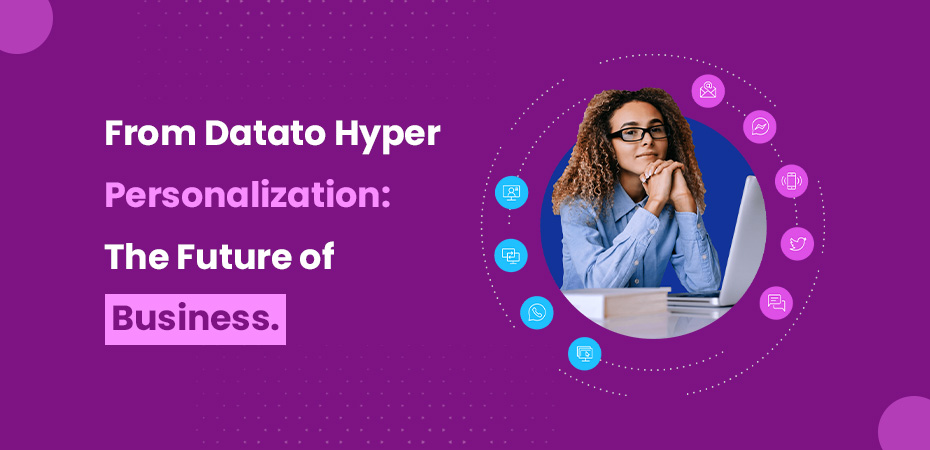From Data to Hyper-Personalization: The Future of Business



Introduction
In today’s world, businesses aren’t just competing on price or product quality—they’re competing on customer experience. People want brands to understand them, predict what they need, and offer personalized experiences. This is where hyper-personalization comes in.
Hyper-personalization takes traditional personalization to the next level. It uses real-time data, artificial intelligence (AI), and automation to create highly customized content, product suggestions, and services. Instead of generic interactions, customers get experiences tailored just for them.
This method makes customers happy, keeps them loyal, and helps businesses sell more. With hyper-personalization, companies can connect with people in a more personal way, making every interaction feel special.
But how does hyper-personalization in marketing work, and why does it matter? Let’s explore how businesses collect data and use it to create unique customer experiences. This strategy is the future of personalization in business.
The Evolution of Personalization in Business
Marketing has come a long way, shifting from generic messaging to highly customized experiences based on customer needs.
- Mass Marketing: In the past, businesses used the same ads and promotions for everyone. There was no personalization, so many customers didn’t feel a real connection with brands.
- Segmented Marketing: Companies then started dividing customers into groups based on factors like age, location, and interests. This helped make marketing more relevant but was still limited.
- Personalization: As businesses collected more customer data, they started sending personalized emails, targeted ads, and product recommendations based on past actions. This made customers feel more valued and improved engagement.
- Hyper-Personalization: Today, AI and machine learning allow businesses to analyze real-time customer behavior. This means companies can deliver highly customized experiences, showing the right content, products, or offers at the perfect moment.
Businesses that don’t use hyper-personalization may lose customers to competitors who offer better, more personal experiences. People now expect brands to understand their likes and needs.
Companies that use AI for personalization can build stronger customer relationships. They can keep customers coming back. This helps them increase sales in a competitive market.
Hyper-Personalization- Definition and Role of Data in it
Hyper-personalization means using AI, Big Data, and automation to create highly tailored experiences for customers. Businesses collect and study large amounts of information. This helps them understand customers better and offer exactly what they need.
There are three main types of data used in hyper-personalization:
- First-party data is information that businesses collect directly from their customers. This includes details like website visits, past purchases, and how customers interact with emails or apps.
- Second-party data: This is shared data from trusted partners. For example, a travel website might get hotel booking data from an airline company to offer better recommendations.
- Third-party data: This comes from external sources and includes information about customer interests, location, and general behavior patterns.
Ethical Considerations & Data Privacy
While using data helps businesses create better customer experiences, it also raises privacy concerns. People want to know how their personal information is being used and whether it is safe.
To build trust, companies must follow privacy laws like GDPR (in Europe) and CCPA (in California). These laws ensure that businesses are transparent about data collection and give customers control over their personal information.
By using data responsibly, companies can create highly personalized experiences while keeping customer trust and privacy a top priority.
Key Technologies Powering Hyper-Personalization
Several advanced technologies help businesses create highly personalized experiences for customers. These technologies analyze data, predict behavior, and deliver content that feels unique to each person.
Artificial Intelligence (AI) & Machine Learning (ML)
AI and ML study customer behavior by analyzing data patterns. They help businesses understand what customers like, predict what they might need next, and provide personalized recommendations. For example, online stores use AI to suggest products based on past purchases.
Big Data & Analytics
Big Data helps businesses collect and process huge amounts of customer information. With real-time analysis, companies can understand trends better. They can offer the right products, services, or content at the perfect time.
Internet of Things (IoT)
IoT devices, like smart home gadgets and wearable tech, collect real-time customer data. These devices learn user habits and adjust settings automatically. For example, a smart thermostat can adjust the temperature based on a person’s daily routine.
Chatbots & Conversational AI
AI-powered chatbots provide instant, personalized customer support. They can answer questions, suggest products, and even guide users based on their past interactions. This makes customer service faster and more efficient.
By using these technologies, businesses can create better experiences for customers, making every interaction feel personal and relevant.
Benefits of Hyper-Personalization for Businesses
Hyper-personalization helps businesses connect better with customers by offering tailored experiences. Here are some key benefits:
Enhanced Customer Experience
People enjoy brands that understand their needs and preferences. When businesses provide personalized recommendations, content, or services, customers feel valued. This leads to higher satisfaction and a better overall experience.
Improved Customer Loyalty
When customers feel special, they are more likely to stick with a brand. If a company remembers their preferences and provides relevant offers, customers will keep coming back. This builds long-term loyalty and trust.
Higher Conversion Rates
Personalized marketing makes it easier to turn visitors into buyers. When people see products or offers that match their interests, they are more likely to make a purchase. This increases engagement and boosts sales.
Competitive Advantage
Companies that use hyper-personalization stand out from the competition. By offering unique and highly relevant experiences, they attract more customers and stay ahead in their industry. Businesses that fail to personalize may lose customers to brands that do.
By using hyper-personalization, businesses can build stronger connections with customers. They can increase sales and stay competitive in the market.
Challenges and Risks of Hyper-Personalization
While hyper-personalization offers great benefits, it also comes with some challenges that businesses must be aware of.
Data Privacy & Security
To personalize experiences, businesses collect a lot of customer data. However, if data is misused or not properly protected, it can lead to security breaches, legal penalties, and loss of customer trust. Companies must follow privacy laws and be transparent about how they use data.
Risk of Over-Personalization
Personalization is helpful, but too much can be uncomfortable. If a brand knows too much or shows too many recommendations, it may feel creepy. Businesses should find a balance. They should give helpful suggestions without making customers feel watched.
High Implementation Costs
Hyper-personalization requires advanced technology like AI, machine learning, and big data analytics. Setting up these systems takes time, expertise, and money. Small businesses, in particular, may find it challenging to afford these tools. However, as technology becomes more accessible, costs may go down over time.
Even with these challenges, businesses can succeed with hyper-personalization. They must handle data carefully, respect customer privacy, and use the right technology. This will help them get the best results and keep customers happy.
Steps to Implement Hyper-Personalization in Your Business
To successfully use hyperpersonalization, businesses need to follow a few key steps:
Collect and Organize Customer Data
Start by gathering customer data, such as their interests, shopping habits, and online behavior. Group similar customers together based on this information so you can create more personalized experiences for each group.
Use AI-Powered Tools
AI and automation tools like Zapier help businesses analyze data quickly and predict what customers might need. These tools can suggest products, personalize emails, and improve customer interactions, making personalization more effective.
Offer Real-Time Personalization
People like to get personal recommendations at the right time. With AI and smart data tools, businesses can send special offers, content, or product suggestions just when a customer needs them. For example, if someone is looking at shoes in an online store, the website can suggest similar styles they might like.
Keep Improving Your Strategy
Personalization is not a one-time process. Businesses should regularly check how well their personalization efforts are working by looking at customer feedback and performance data. If something isn’t working, they should adjust their hyper-personalization approach to make it better.
By following these steps, businesses can build stronger hyper-personal relationships with customers. They can create highly personalized experiences. This helps increase sales and keeps customers engaged.
The Future of Hyper-Personalization
Hyper-personalization will continue to grow as technology improves. AI and automation will become even smarter, helping businesses understand customers better and predict their needs more accurately. This will make personalized experiences even more relevant and effective.
Keeping customer data safe is very important. Blockchain technology can help businesses be more open about how they use data. With blockchain, customers can feel safer because their personal information is protected and handled responsibly.
Web3, the next version of the internet, will also change how data is controlled. Instead of companies owning all the customer data, people will have more control over their own information. This means businesses can still offer personalized experiences but in a way that respects customer privacy.
As these technologies grow, businesses that use hyper-personalization in a fair and honest way will stand out. They will gain customer trust and create even better experiences for their audience.
Conclusion
Hyper-personalization is not just a bonus anymore. Businesses need it to stay competitive. By using AI, Big Data, and automation, companies can create personal experiences. This makes customers happy and helps businesses grow.
If you want to improve your digital marketing and use hyper-personalization to grow your business, Phoenix SEO Ninja can help. Our advanced SEO and marketing services help businesses strengthen their online presence and connect better with their customers.
Frequently Asked Questions (FAQs)
Hyper-personalization uses AI and real-time data to create highly customized experiences, while traditional personalization relies on basic demographic data.
E-commerce, finance, healthcare, entertainment, and retail benefit the most from hyper-personalization models in marketing.
Small businesses can use AI-driven marketing tools, CRM systems (like Salesforce), and automation platforms to personalize customer interactions.
Data privacy concerns, regulatory compliance, over-personalization, and high implementation costs are some challenges businesses face.
By following GDPR, CCPA regulations, using ethical data collection methods, and implementing strong cybersecurity measures.